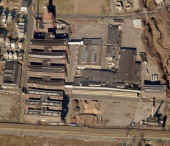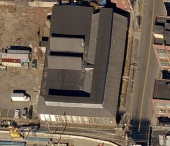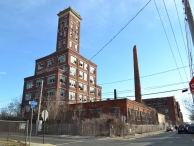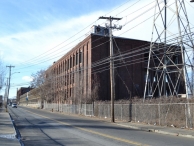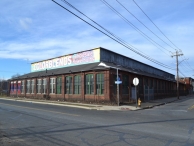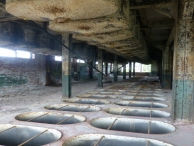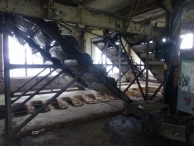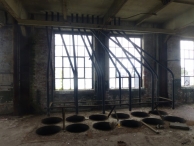Mill Record Bridgeport
RETURN TO ‘FIND MILLS’Disclaimer: Content for these properties was compiled in 2014-2017 from a variety of sources and is subject to change. Updates are occasionally made under Property Information, however the Connecticut Trust for Historic Preservation (dba Preservation Connecticut) makes no representation or warranty that the information is complete or up-to-date.
- Complex Name (Common)
- Remington Arms-Union Metallic Cartridge Co. DEMO EXCEPT SHOT TOWER
- Complex Name (Historic)
-
- Remington Arms-Union Metallic Cartridge Co.
- Address or Location
- 761 & 889 Barnum Avenue, Bridgeport
- County
- Fairfield
- Historic Designation
- Associated Mill Community
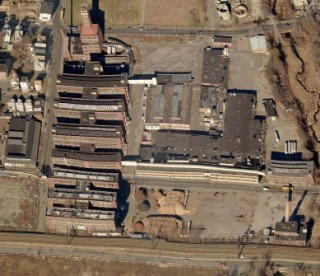
- Historic Information
Companies Associated w/Complex
- Remgrit Corp. 1986-1987
- Remington Arms Co., Div. E.I. DuPont de Nemours & Co. 1933-1986
- Remington Arms-Union Metallic Cartridge Co. ca. 1900-1933
Use (Historic)
Largest Documented Workforce
Over 1,000 (1939).
Historic Narrative
The development of the former Remington Arms-Union Metallic Cartridge Company complex began under one of the company’s predecessors, the Union Metallic Cartridge Company, during the late 1860s. As Matthew Roth notes in his detailed history of the company published in ‘Connecticut; An Inventory of Historic Engineering and Industrial Sites,’ in 1980, ‘The establishment of Union Metallic Cartridge Co. by Marcellus Hartley in 1867 illustrates the changing relationship between financiers and technologists in the latter 19th century. Hartley, a New York City sporting-arms dealer who had served in Europe as arms procurement representative for the U.S. during the Civil War, foresaw the replacement of paper rifle cartridges by metallic ones and formed U.M.C. to capitalize on this change. Expert in marketing and finance, Hartley was nonetheless totally ignorant of production techniques, a defect he remedied by hiring Alfred C. Hobbs, former superintendent of Howe Sewing Machine Co., to develop manufacturing equipment. Most of the metal-forming operations that Hobbs installed were simply specialized refinements of known die-forming practice, but Hobbs' machinery for loading the shells was unique: a conveyor carried formed cartridges under a hopper where each case was filled with an automatically measured charge of powder. By 1870 Hobbs' production line was producing 120,000 cartridges per day…’ ‘In 1888 Hartley bought E. Remington and Son, arms manufacturers from Ilion, NY, and combined the firms as Remington-U.M.C., though mostly separate operations were maintained. During World War I both divisions were major contributors of Allied military material. Most of the current plant dates from 1914-1916, when it grew from 143 buildings with 16 acres of floor space to 313 buildings with 40 acres. Most of that new manufacturing space was in two complexes north and south of Barnum Ave… In 1933, after three years of plummeting sales, Remington-U.M.C. offered controlling interest to E.I. DuPont de Nemours and Co.’ Under DuPont’s control, the Remington Arms Company continued to manufacture many of the same products it had turned out since the First World War, which included munitions, firearms, bayonets, and pocket knives. When Roth surveyed the facility during the late 1970s DuPont continued to operate much of the plant, however, around 1980, a portion of the property north of St. Augustine Cemetery (identified in this survey as the ‘Northern Plant’) was sold to the Alimak Elevator Company and a number of the historic factory buildings on the site were demolished for new construction. DuPont eventually closed the remainder of the plant and sold it off to various new owners in 1986. The portion of the complex south of Arctic Street (identified in this survey as the ‘Southern Plant’) was purchased by the Remgrit Corporation, an abrasives and cutting tool manufacturer. Remgrit retained the property for just one year before it was sold to the present owner, a development company.
- Architectural Information
Number of Existing Buildings
Roughly eleven (11) primary blocks.
Dates of Construction
ca. 1900, 1909, 1914-1916, 1964.
Architect
n/a
Builder
n/a
Building Type
Architectural Description
When Matthew Roth surveyed the former Remington Arms-Union Metallic Cartridge Company plant in 1980 the majority of the facility both north and south of Barnum Avenue remained intact. Since that time, however, all of the blocks previously located south of Barnum Avenue have been demolished, as have the majority once located on the interiors of the portions of the complex situtated north of Barnum Avenue and south of Arctic Street (Southern Plant), and south of Boston Avenue and north of St. Augustine Cemetery (Northern Plant, see resource #3892 for description, which Roth did not address). The oldest extant building in the Southern Plant is a three-and-a-half-story, 172’ x 82’ office block standing immediately north of Barnum Avenue and roughly 815’ east of Helen Street. Built ca. 1900, it has red brick walls, full-height window bays with corbelled headers, segmental-arched window openings with stone sills, a corbelled red brick cornice, and a flat roof with two sawtooth monitors. The basement windows have ten-over-ten double-hung wood sash, while those on the upper stories were likely 15-over-15 arrangements. The primary entrance lacks any original doors, sidelights, or a transom, yet retains its stone surround comprised of fluted pilasters and a denticulated and molded cornice. The second oldest surviving building associated with the plant is the ten-story, 66’ x 90’ red brick shot tower located at the northwest corner of the complex. Built in 1909, the shot tower is a three-tiered structure, with the first tier standing four stories tall, the second two stories, and the final section rising the final four floors to the top of the building. The building has large rectangular window openings with cast stone sills and lintels, multipane steel sash, corbelled red brick cornices, and a cast stone entablature, modillioned cornice, and rooftop balustrade. A one-story, 78’ x 90’ red brick block adjoins the shot tower’s west elevation. One of the largest components of the plant was located south of the shot tower and extended all the way to Barnum Avenue. This consisted of a series of red brick blocks unified by a central spine that were erected between 1914 and 1916. The central section originally measured 625' x 60' and connected five sets of attached buildings, each 125' x 75' except for the southern pair, which were 60' wide. The northernmost block stands one story tall, while the remainder are all four stories in height. The second block south of the shot tower was demolished during the early 2010s, as were the central spines extending north and south from that block. The surviving section extends 282’ from north to south. It has red brick walls, large rectangular window openings with concrete sills and multipane steel sash, corbelled red brick cornices, and flat roofs with either sawtooth or clerestory monitors. Another component of the plant erected between 1914 and 1916 is the one-story red brick machine shop located on the west side of Helen Street. This measures approximately 114’ x 222’ and has a concrete foundation, red brick walls, segmental-arched window openings with paired fenestration and concrete sills, nine-over-nine double-hung wood wash, a widely overhanging hipped roof with exposed rafter tails, and both gabled and sawtooth monitors. The final primary surviving section of the plant was built on the west side of the ca. 1900 office building in 1964. The building replaced several preexisting blocks and is a two-story, 440’ x 50’ steel-frame and concrete structure. It has a concrete foundation, concrete wall panels, and a flat roof. The wall panels are shaped so as to create full-height window bays flanked by concrete ribs and with concave window openings framed by concave concrete sills and lintels. The fixed plate glass windows are divided into pairs by concrete mullions. Second-story covered passageways link the building with the blocks immediately to the east and west.
Exterior Material(s)
Structural System(s)
Roof Form
Roof Material
Power Source
Condition
Fair, Deteriorated
Condition Notes
The complex is in fair to deteriorated condition. The windows and interiors of all of the buildings are either damaged, deteriorated, or missing, however, structurally, most of the blocks appear sound and salvageable.
- Property Information
-
Specific Location
Two parcels (761 & 889 Barnum Avenue) totaling 7.43 acres located on the north side of Union Avenue, at the northeast and northwest corners of the intersection of Barnum Avenue and Helen Street.
Adjacent To
Exterior Visible from Public Road?
Yes
Parcel ID / Assessor Record Link
Acreage
7.43
Use (Present)
- Abandoned
- Commercial
- Other: The City of Bridgeport commissioned/completed both the Barnum Station TOD Master Plan (OPM funding) and Adaptive Reuse Strategy for Tower Place, the Remington shot tower and remaining factory buildings (DECD funding) in 2017. Goody Clancy was consultant for both. In Feb 2020, city began planning for stabilization of shot tower. Stabilization work in process October 2021. (https://www.bridgeportct.gov/filestorage/341650/341652/346105/342427/353914/170109_BarnumStationTODPlan.pdf) (https://www.bridgeportct.gov/filestorage/341650/341652/346105/342427/353914/170921_TowerPlaceAdaptiveReuseStrategy-HI.pdf) 4/2023 demolition of buildings began
- Vacant
- Sources
-
Form Completed By
Lucas A. Karmazinas
Date
01/22/2016
Bibliography
- List of Connecticut Manufacturers, 1922, 1924, 1930, 1932.
- Directory of Connecticut State Manufacturers, 1936, 1939.
- Industrial Directory of Connecticut, 1947.
- Register of War Production Facilities in Connecticut, 1951.
- Map of Fairfield County; Baker, William A., 1854.
- Atlas of the City of Bridgeport; J.B. Beers & Co., 1876.
- Atlas of the City and Town of Bridgeport; G.M. Hopkins & Co., 1888, 1917.
- Atlas of Bridgeport; Kershaw, William H., 1910.
- Sanborn Map Company, 1884, 1888, 1898, 1904, 1913, 1939, 1950.
- Aerial Survey of Connecticut, 1934, 1951, 1965, 1970, 1985.
- Bridgeport City Directory, Various editions.
- A History of the Old Town of Stratford and the City of Bridgeport; Orcutt, Samuel, 1886.
- History of Bridgeport and Vicinity; S.J. Clarke Publishing, 1917.
- Connecticut; An Inventory of Historic Engineering and Industrial Sites; Roth, Matthew, 1980.
- Representative View(s)Click on image to view full file
